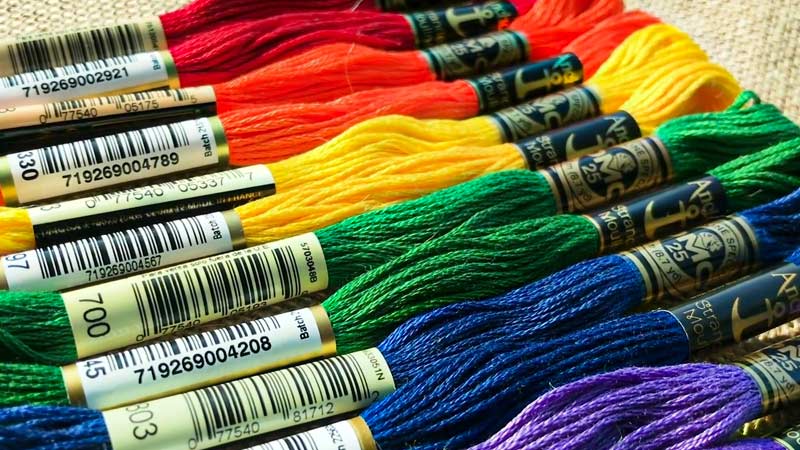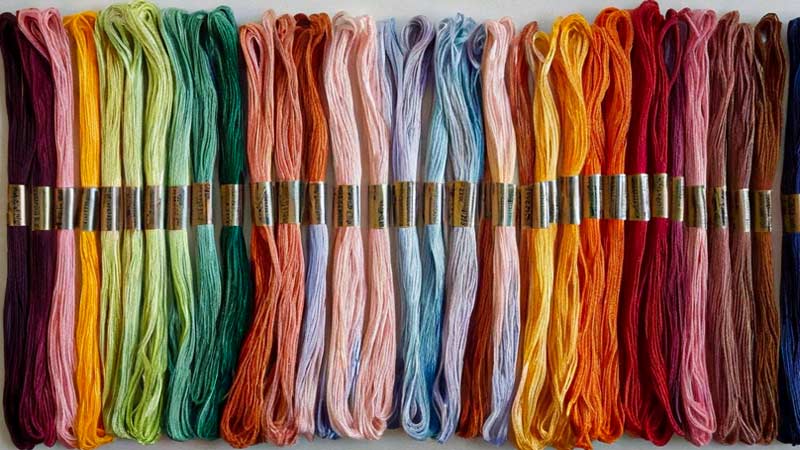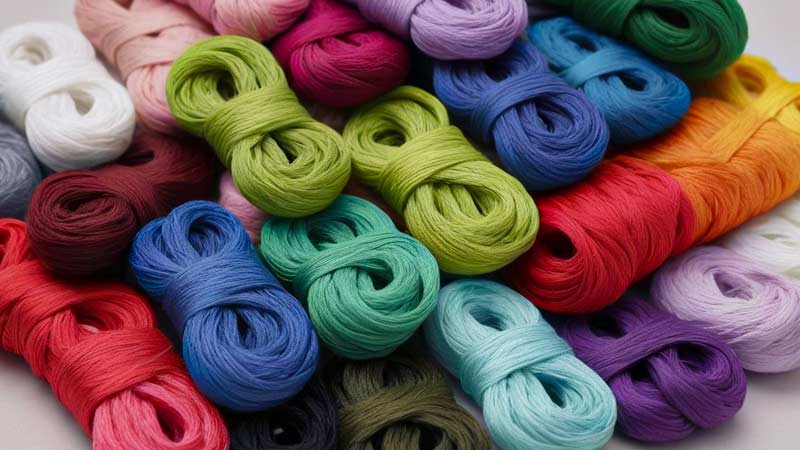As an embroidery enthusiast, I’ve often marveled at embroidery floss’s vibrant colors and smooth texture. But have you ever wondered what this essential crafting material is made of? Let’s take a closer look.
Embroidery floss, that rainbow-hued staple in every needleworker’s toolkit, typically comprises cotton, silk, or rayon.
These materials are chosen for their durability and shine, which help your handiwork stand out. Cotton is the most popular choice due to its affordability and versatility.
The fibers used in embroidery floss are carefully spun together to create a thread that’s not only strong but also has a slight sheen.
This process gives the final product its signature look and feel, which sets it apart from ordinary sewing threads.
So next time you’re threading your needle with that glossy strand of color, remember there’s more to it than meets the eye.

What Is Embroidery Floss?
Embroidery floss, I’ve come to find, is the thread used in embroidery and cross-stitch. It’s a type of yarn that’s designed explicitly for needlework. But what makes it so unique? Well, it all comes down to its structure.
Unlike ordinary threads, embroidery floss comprises six individual strands or “plies.” These plies are twisted together to form a single strand of floss.
What’s cool about this design is that you can separate the strands to adjust the thickness of your stitches.
Now let me tell you something intriguing: Embroidery floss isn’t one-size-fits-all. It comes in different types based on their material composition.
Most commonly, you’ll encounter:
- Cotton Floss: This is your everyday workhorse in the world of embroidery – affordable, easy to work with, and available in a rainbow of colors.
- Silk Floss: Oozing elegance and sheen, silk floss adds an upscale touch to any piece but can be slightly more demanding on your wallet.
- Metallic Floss: Want some sparkle? Metallic floss has got you covered! However, it can be tricky to handle due to its slippery nature.
I’ve also heard whispers about rayon and linen embroidery flosses, though they’re not as common as their cotton, silk, or metallic counterparts.
So there we have it! Embroidery floss – is an essential ingredient in creating beautiful needlework pieces – whether stitching a picturesque landscape or adding details to your favorite denim jacket.
Stay tuned because we’ll dive deeper into each type of embroidery material in subsequent sections.
History of Embroidery Floss

Embroidery floss, a staple in the world of needlework, has a fascinating history that spans centuries and continents.
From ancient civilizations to modern-day crafters, the evolution of embroidery floss reflects advancements in technology, trade, and artistic expression.
Ancient Origins
The roots of embroidery floss can be traced back to ancient cultures such as Egypt, China, and India. As early as 3000 BC, flax threads were spun and dyed for intricate needlework using natural resources like berries and insects in Egypt.
Similarly, silk threads gained popularity in China around 2640 BC, showcasing the luxurious craftsmanship of Chinese artisans.
Medieval Europe
During the Middle Ages, wool was the primary material for embroidery floss in Europe. From ornate ecclesiastical garments to elaborate tapestries, wool threads were meticulously stitched to create intricate designs reflecting religious themes, heraldry, and daily life.
Renaissance and Beyond
The Renaissance era brought about advancements in dyeing techniques, leading to a broader spectrum of colors available for embroidery floss.
With increased trade and exploration, materials such as cotton from the Americas and silk from Asia became more accessible, providing embroiderers with a broader range of options for their craft.
Industrial Revolution
The Industrial Revolution transformed the production of embroidery floss. Mechanized spinning and weaving technologies enabled mass production, making threads more affordable and readily available.
This led to the commercialization of embroidery floss, with manufacturers producing pre-dyed skeins in various colors and textures.
Modern Innovations
Today, embroidery floss is crafted from multiple materials, including cotton, silk, linen, and synthetic fibers.
With technological advancements, embroiderers have access to an extensive palette of colors and finishes, allowing for greater creativity and expression in their designs.
From traditional hand embroidery to computerized machines, the art of embroidery continues to evolve, blending time-honored techniques with contemporary innovations.
Cultural Significance
Historically, embroidery floss has significantly influenced artistic expression and identity. From traditional folk motifs to modern interpretations, embroidery serves as a means of storytelling, preserving heritage, and connecting communities across generations.
Types of Embroidery Floss

You might’ve wondered what materials go into that beautiful, colorful embroidery floss you use for your projects.
Well, I’m here to shed some light on the subject! Several types of embroidery floss are available today, each with unique characteristics and qualities.
One of the most popular types is cotton floss. It’s loved by many for its soft texture and versatility. Most commonly used in cross-stitching, this type comes in a wide range of colors and thicknesses to suit various needs.
Cotton floss can be divided into stranded cotton (also known as six-strand floss), pearl or perle cotton, soft cotton (which has a matte finish), and cotton à broder (explicitly used for whitework embroidery).
Next up is silk floss. If you want something with more shine and smoothness, silk would be your go-to option. It’s ideal for projects that require fine detail or a glossy finish.
Silk threads come in stranded silk (similar to stranded cotton but with more luster), spun silk (with a subtle sheen perfect for surface stitching), flat silk (known for its high gloss), and twisted filo-selle silk.
Then there’s rayon floss – an exceptional sheen that makes it stand out from other types of floss. However, it can be pretty slippery, which may pose a challenge during stitching.
Here’s another interesting one – metallic thread! This adds sparkle to any project but can be tricky due to its tendency to fray easily.
Lastly, we have wool threads, which are coarser than their counterparts but provide an interesting texture when stitched onto fabric.
Let’s summarize these:
| Type | Characteristics |
|---|---|
| Cotton Floss | Soft, versatile |
| Silk Floss | Shiny, smooth |
| Rayon Floss | Glossy, slippery |
| Metallic Thread | Sparkly, can fray easily |
| Wool Threads | Coarse, textured |
Each type has its pros and cons, so the choice ultimately depends on what effect you’re going for in your embroidery project.
Whether it be cotton’s softness, silk’s shine, rayon’s glossiness, metallic thread’s sparkle, or wool’s texture – there’s undoubtedly a floss out there that fits your unique needs!
Common Materials Used to Make Embroidery Floss
Embroidery floss, the colorful thread beloved by crafters worldwide, is crafted from various materials, each offering distinct characteristics and benefits.
Here are some of the most common materials used to make embroidery floss:
Cotton

Cotton is the most widely used material for creating embroidery floss. It is prized for its affordability, soft texture, and wide availability.
Cotton floss can be easily dyed in many colors, allowing embroiderers to unleash their creativity without constraints.
Additionally, cotton is durable and easy to work with, making it ideal for beginners and experienced stitchers.
Silk
Silk embroidery floss exudes luxury and elegance. While more expensive than cotton, silk offers a luminous sheen and smoothness unmatched by other materials.
Silk threads are highly prized for their strength and durability, making them well-suited for intricate and detailed embroidery work. The fine texture of silk lends a refined finish to projects, elevating the overall aesthetic.
Rayon
Rayon is a synthetic fiber known for its bright shine and versatility. While not as durable as silk or cotton, rayon embroidery floss stands out with its high sheen finish, adding a touch of glamour to any project.
Rayon threads are often chosen for decorative stitching and embellishments, as they beautifully catch and reflect light, enhancing the visual impact of the design.
Linen
Linen embroidery floss adds a rustic charm to projects with its unique texture and appearance. Although less commonly used compared to cotton and silk, linen threads offer a distinct character that appeals to many stitchers.
Linen is known for its durability and strength, making it suitable for projects that require resilience. Additionally, linen floss can lend a vintage-inspired look to embroidery, adding depth and character to the final piece.
Specialty Threads
In addition to the standard materials mentioned above, there are specialty threads that add extra dimension and visual interest to embroidery projects:
- Metallic Floss: Made by wrapping a thin metal foil around a core thread, metallic floss creates a dazzling shimmer effect, adding sparkle and glamour to embroidery designs.
- Variegated Floss: This type of floss features multiple colors blended along the length of the thread, creating a gradient or color-changing effect. Variegated floss is perfect for adding depth and dimension to the stitching without switching threads frequently.
Conclusion
We’ve taken a deep dive into the world of embroidery floss, and I hope you’ve found it as fascinating as I have. What we’re dealing with isn’t just some mundane thread but a complex product of human ingenuity and natural resources.
Primarily made from cotton, silk, rayon, or polyester, embroidery floss comes in an almost infinite variety of colors. Each type has unique characteristics that make it suitable for different projects.
Cotton is durable and easy to use; silk offers unparalleled elegance; rayon gives your project a shiny finish, while polyester provides strength and longevity.
Here’s a quick summary:
- Cotton – Durable, user-friendly
- Silk – Luxurious, delicate
- Rayon – Shiny finish
- Polyester – Strong, long-lasting
Unfortunately, there’s no one-size-fits-all answer on which type to use for your projects. It all depends on what you’re aiming to achieve aesthetically and functionally.
To help you decide what material might be best for your next project, consider the following: Are you going for elegance or durability? Do you want bright colors or subtle shades? Your answers will guide you toward the right choice.
I recommend starting with cotton threads for beginners still navigating embroidery flosses. They offer ease-of-use and are widely available at affordable prices.
However, as your skills progress past the novice level, you’ll experiment with different materials such as silk or rayon.
Leave a Reply